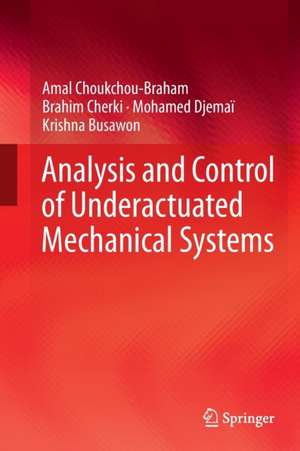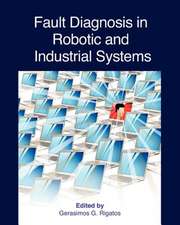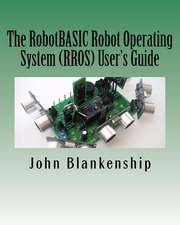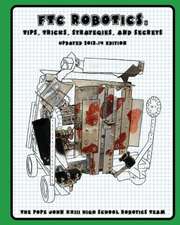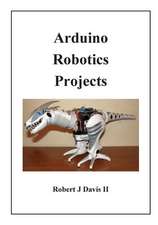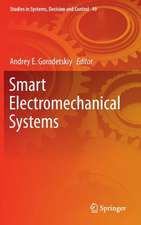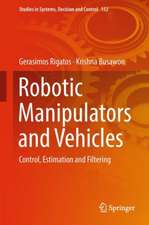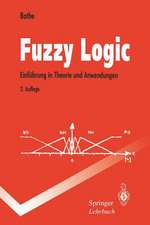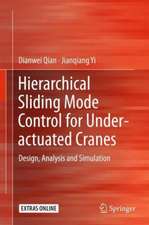Analysis and Control of Underactuated Mechanical Systems
Autor Amal Choukchou-Braham, Brahim Cherki, Mohamed Djemaï, Krishna Busawonen Limba Engleză Paperback – 17 sep 2016
The authors take as their starting point the construction of a graphical characterization or control flow diagram reflecting the transmission of generalized forces through the degrees of freedom. Underactuated systems are classified according to the three main structures by which this is found to happen—chain, tree, and isolated vertex—and control design procedures proposed. The procedure is applied to several well-known examples of underactuated systems: acrobot; pendubot; Tora system; ball and beam; inertia wheel; and robotic arm with elastic joint.
®/Simulink® simulations that demonstrate the effectiveness of the methods detailed. Readers interested in aircraft, vehicle control or various forms of walking robot will be able to learn from Underactuated Mechanical Systems how to estimate the degree of complexity required in the control design of several classes of underactuated systems and proceed on to further generate more systematic control laws according to its methods of analysis.
| Toate formatele și edițiile | Preț | Express |
|---|---|---|
| Paperback (1) | 633.53 lei 6-8 săpt. | |
| Springer International Publishing – 17 sep 2016 | 633.53 lei 6-8 săpt. | |
| Hardback (1) | 639.73 lei 6-8 săpt. | |
| Springer International Publishing – 25 noi 2013 | 639.73 lei 6-8 săpt. |
Preț: 633.53 lei
Preț vechi: 745.32 lei
-15% Nou
Puncte Express: 950
Preț estimativ în valută:
121.24€ • 126.42$ • 100.76£
121.24€ • 126.42$ • 100.76£
Carte tipărită la comandă
Livrare economică 20 martie-03 aprilie
Preluare comenzi: 021 569.72.76
Specificații
ISBN-13: 9783319377551
ISBN-10: 3319377558
Pagini: 153
Ilustrații: XV, 138 p. 55 illus., 10 illus. in color.
Dimensiuni: 155 x 235 x 8 mm
Greutate: 0.23 kg
Ediția:Softcover reprint of the original 1st ed. 2014
Editura: Springer International Publishing
Colecția Springer
Locul publicării:Cham, Switzerland
ISBN-10: 3319377558
Pagini: 153
Ilustrații: XV, 138 p. 55 illus., 10 illus. in color.
Dimensiuni: 155 x 235 x 8 mm
Greutate: 0.23 kg
Ediția:Softcover reprint of the original 1st ed. 2014
Editura: Springer International Publishing
Colecția Springer
Locul publicării:Cham, Switzerland
Cuprins
Introduction.- Generalities and State-of-the-Art on the Control of Underactuated Mechanical Systems.- Underactuated Mechanical Systems from the Langrangian formalism.- Classification of Underactuated Mechanical Systems.- Control Design Schemes for Underactuated Mechanical Systems.- Appendices: Theoretical Background on Nonlinear System Stability and Control.- Limits of Linearization and Dangers of Destabilization.- Differential Geometry.- Controllability of Continuous Systems.
Recenzii
“The aim of the book consists of presenting reference material for researchers and students working in the field of underactuated mechanical systems. The book can also serve as a complementary reading for post-graduate students studying control systems theory. … The book is well written and contains new and classical results in the analysis and control of underactuated mechanical systems, showing the differences and relations from different points of view.” (Leonardo Colombo, Mathematical Reviews, February, 2016)
Textul de pe ultima copertă
This monograph provides readers with tools for the analysis, and control of systems with fewer control inputs than degrees of freedom to be controlled, i.e., underactuated systems. The text deals with the consequences of a lack of a general theory that would allow methodical treatment of such systems and the ad hoc approach to control design that often results, imposing a level of organization whenever the latter is lacking.
The authors take as their starting point the construction of a graphical characterization or control flow diagram reflecting the transmission of generalized forces through the degrees of freedom. Underactuated systems are classified according to the three main structures by which this is found to happen—chain, tree, and isolated vertex—and control design procedures proposed. The procedure is applied to several well-known examples of underactuated systems: acrobot; pendubot; Tora system; ball and beam; inertia wheel; and robotic arm with elastic joint.
®/Simulink® simulations that demonstrate the effectiveness of the methods detailed. Readers interested in aircraft, vehicle control or various forms of walking robot will be able to learn from Analysis and Control of Underactuated Mechanical Systems how to estimate the degree of complexity required in the control design of several classes of underactuated systems and proceed on to further generate more systematic control laws according to its methods of analysis.
The authors take as their starting point the construction of a graphical characterization or control flow diagram reflecting the transmission of generalized forces through the degrees of freedom. Underactuated systems are classified according to the three main structures by which this is found to happen—chain, tree, and isolated vertex—and control design procedures proposed. The procedure is applied to several well-known examples of underactuated systems: acrobot; pendubot; Tora system; ball and beam; inertia wheel; and robotic arm with elastic joint.
®/Simulink® simulations that demonstrate the effectiveness of the methods detailed. Readers interested in aircraft, vehicle control or various forms of walking robot will be able to learn from Analysis and Control of Underactuated Mechanical Systems how to estimate the degree of complexity required in the control design of several classes of underactuated systems and proceed on to further generate more systematic control laws according to its methods of analysis.
Caracteristici
Shows the reader how to impose an ordered method of control and observer design on a group of systems that usually require a case-by-case approach, saving time, computational effort and expense Extensively illustrated with MATLAB®/Simulink® simulations exemplifying the effectiveness of the methods described Applicable to a disparate group of systems ranging from walking robots to aircraft Includes supplementary material: sn.pub/extras
